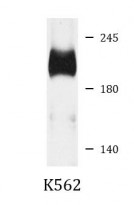ARG59158
anti-WRN antibody
anti-WRN antibody for Western blot and Human
Overview
| Product Description | Rabbit Polyclonal antibody recognizes WRN |
|---|---|
| Tested Reactivity | Hu |
| Tested Application | WB |
| Host | Rabbit |
| Clonality | Polyclonal |
| Isotype | IgG |
| Target Name | WRN |
| Antigen Species | Human |
| Immunogen | Recombinant fusion protein corresponding to aa. 1223-1432 of Human WRN (NP_000544.2). |
| Conjugation | Un-conjugated |
| Alternate Names | Exonuclease WRN; RecQ3; Werner syndrome ATP-dependent helicase; RECQL3; RECQL2; RECQ3; EC 3.1.-.-; RecQ protein-like 2; EC 3.6.4.12; DNA helicase, RecQ-like type 3 |
Application Instructions
| Application Suggestion |
|
||||
|---|---|---|---|---|---|
| Application Note | * The dilutions indicate recommended starting dilutions and the optimal dilutions or concentrations should be determined by the scientist. | ||||
| Positive Control | K562 | ||||
| Observed Size | 200 kDa |
Properties
| Form | Liquid |
|---|---|
| Purification | Affinity purified. |
| Buffer | PBS (pH 7.3), 0.02% Sodium azide and 50% Glycerol. |
| Preservative | 0.02% Sodium azide |
| Stabilizer | 50% Glycerol |
| Storage Instruction | For continuous use, store undiluted antibody at 2-8°C for up to a week. For long-term storage, aliquot and store at -20°C. Storage in frost free freezers is not recommended. Avoid repeated freeze/thaw cycles. Suggest spin the vial prior to opening. The antibody solution should be gently mixed before use. |
| Note | For laboratory research only, not for drug, diagnostic or other use. |
Bioinformation
| Database Links |
Swiss-port # Q14191 Human Werner syndrome ATP-dependent helicase |
|---|---|
| Gene Symbol | WRN |
| Gene Full Name | Werner syndrome, RecQ helicase-like |
| Background | This gene encodes a member of the RecQ subfamily and the DEAH (Asp-Glu-Ala-His) subfamily of DNA and RNA helicases. DNA helicases are involved in many aspects of DNA metabolism, including transcription, replication, recombination, and repair. This protein contains a nuclear localization signal in the C-terminus and shows a predominant nucleolar localization. It possesses an intrinsic 3' to 5' DNA helicase activity, and is also a 3' to 5' exonuclease. Based on interactions between this protein and Ku70/80 heterodimer in DNA end processing, this protein may be involved in the repair of double strand DNA breaks. Defects in this gene are the cause of Werner syndrome, an autosomal recessive disorder characterized by premature aging. [provided by RefSeq, Jul 2008] |
| Function | Multifunctional enzyme that has both magnesium and ATP-dependent DNA-helicase activity and 3'->5' exonuclease activity towards double-stranded DNA with a 5'-overhang. Has no nuclease activity towards single-stranded DNA or blunt-ended double-stranded DNA. Binds preferentially to DNA substrates containing alternate secondary structures, such as replication forks and Holliday junctions. May play an important role in the dissociation of joint DNA molecules that can arise as products of homologous recombination, at stalled replication forks or during DNA repair. Alleviates stalling of DNA polymerases at the site of DNA lesions. Important for genomic integrity. Plays a role in the formation of DNA replication focal centers; stably associates with foci elements generating binding sites for RP-A (By similarity). Plays a role in double-strand break repair after gamma-irradiation. [UniProt] |
| Cellular Localization | Nucleus, nucleolus. Nucleus. Nucleus, nucleoplasm. Note=Gamma-irradiation leads to its translocation from nucleoli to nucleoplasm and PML regulates the irradiation-induced WRN relocation. [UniProt] |
| Calculated MW | 162 kDa |
| PTM | Phosphorylated by PRKDC. [UniProt] |
Images (1) Click the Picture to Zoom In






